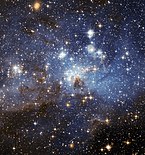Pre-main-sequence star
| Star formation |
|---|
 |
| Object classes |
| Theoretical concepts |
This article needs additional citations for verification. (August 2014) |
A pre-main-sequence star (also known as a PMS star and PMS object) is a
zero age main sequence. This period of contraction is the pre-main sequence stage.[1][2][3][4] An observed PMS object can either be a T Tauri star, if it has fewer than 2 solar masses (M☉), or else a Herbig Ae/Be star, if it has 2 to 8 M☉. Yet more massive stars have no pre-main-sequence stage because they contract too quickly as protostars. By the time they become visible, the hydrogen in their centers is already fusing and they are main-sequence
objects.
The energy source of PMS objects is
gravitational contraction, as opposed to hydrogen burning in main-sequence stars. In the Hertzsprung–Russell diagram, pre-main-sequence stars with more than 0.5 M☉ first move vertically downward along Hayashi tracks, then leftward and horizontally along Henyey tracks, until they finally halt at the main sequence. Pre-main-sequence stars with less than 0.5 M☉ contract vertically along the Hayashi track
for their entire evolution.
PMS stars can be differentiated empirically from main-sequence stars by using stellar spectra to measure their surface gravity. A PMS object has a larger radius than a main-sequence star with the same
planet formation
.
See also
References
- S2CID 18104309.
- ISBN 978-1-4292-5520-2.
- ISBN 978-1-107-62746-8.
- ISBN 978-3-527-40559-6.
